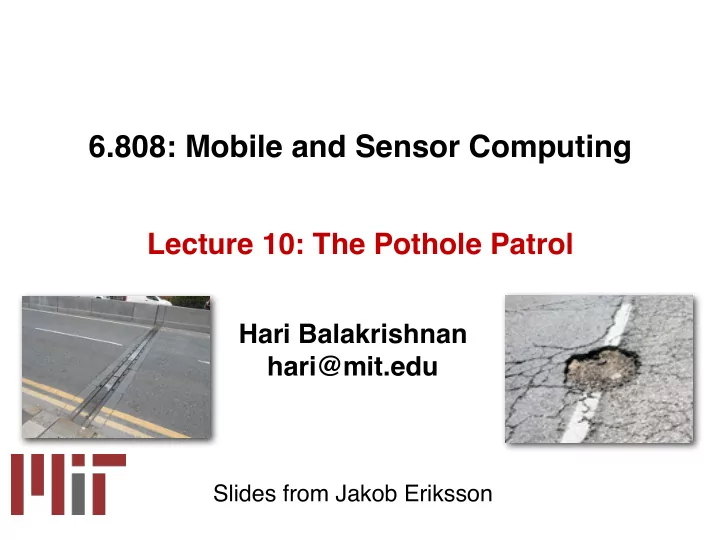

6.808: Mobile and Sensor Computing Lecture 10: The Pothole Patrol Hari Balakrishnan hari@mit.edu Slides from Jakob Eriksson
• road decay unavoidable, hard to predict • current monitoring methods costly/ineffective 3
the Pothole Patrol GPS localization opportunistic accelerometer sensing GPS localization 3-axis accelerometer (380 Hz) opportunistic data upload aggregation and reporting ' P o t h o l e d e t e c t e d a t . . . . ' P2 Central Server Open WiFi Access Point 4
Acceleration vector az: perpendicular to road plane Road ay: road direction ax: on road plane, perpendicular to road 5
experimental platform • 7 Boston/Cambridge taxis • small computer in glove box • 380 Hz 3-axis accelerometer • 802.11a/b/g wireless interface • GPS receiver on roof • <time,location,heading,speed,ax,ay,az> 6
wide-area sensing 7
8
1 Fraction of road segments 0.9 0.8 7 cars in 10 days 0.7 0.6 2492 unique km 0.5 9730 total km 0.4 0.3 0.2 0.1 0 1 10 100 1000 Number of repeat encounters appear @ least once 9
P 2 architecture Vehicle clients Central server Sensors Location Pothole Clustering Interpolator Detector x x x x GPS x Pothole x xx Record 3-Axis 1.1 2.6 1.5 accelero- meter 10
sensor placement Pros? Cons? • highly accurate try to stay • difficult mounting inside vehicle • extreme exposure
Attached to Windshield 600 • very clean signal Acceleration (raw) 580 WINDSHIELD? • ‘gold standard’ 560 540 • difficult to mount 520 500 480 371 372 373 374 375 376 Time into trace (sec) Attached to Dashboard • good signal 570 Acceleration (raw) 560 DASHBOARD? 550 • easy to mount 540 530 • ‘out of the way’ 520 510 500 490 368 369 370 371 372 373 Attached to Embedded PC Time into trace (sec) 80 Acceleration (raw) 60 • very poor signal ATTACHED TO PC? 40 20 • no mounting necessary 0 -20 -40 354 355 356 357 358 359 Time into trace (sec) 12
challenge: “pothole” v. “not pothole” How do I identify pothole vs others? 13
pothole v. not pothole 14
P 2 detector expansion joints smaller highway rail crossings anomalies speed bumps OUT speed vs. pothole xz-ratio z ratio detections IN 256-sample windows high-pass z-peak speed windows of all event classes door slams, acceleration, minor curbs braking, turns anomalies Events usually of much shorter duration than 256 samples 16
P 2 detector expansion joints smaller highway rail crossings anomalies speed bumps OUT speed vs. pothole xz-ratio z ratio detections IN 256-sample windows high-pass z-peak speed windows of all event classes door slams, acceleration, minor curbs braking, turns anomalies Events usually of much shorter duration than 256 samples Need to learn threshold parameters (will come back to it later) 17
18
x-z ratio “high enough” 19
hand-labeled training data 20
training the detector • manually label training samples Type Count Percentage Smooth road (SM) 64 23% Potholes (PH) 63 23% Manholes (MH) 59 21% Railroad Crossing (RC) 18 6% Crosswalk/Exp. Joint (CWEJ) 76 27% 21
loosely-labeled training • needed to avoid over-training with unrepresentative manually curated data • under-samples “smooth” roads 22
training the detector • pick an objective function For each set of parameter score s ( t ) = corr − incorr 2 . detections reported when using • optimize over 3 threshold parameters • z-peak • xy-ratio • speed vs. z-ratio 23
detector performance Among the segmented reported as potholes by the algorithm After training on loosely labeled data E.g., 7.3% of detected “potholes” are railroad Note: Actual false positive rate is not 7.6% Why? 24
estimating false +ve rate # of sample # of detections/ windows # windows Road # potholes #win #det. rate Storrow Dr. few 1865 3 0.16% upper bound on Memorial Dr. few 1781 2 0.12% FPs Hwy I-93 few 2877 5 0.17% Binney St some 6887 25 0.63% Beacham St many 1643 231 14% 25
clustering 26
experiments • 7 taxis over 10 days • 9730 total km of road covered • 2492 unique km of road covered • 1.4 million sample windows • 4131 severe detections in 2709 locations (after clustering) 27
28
48 spot-checks potholes 39 sunk-in 3 manholes railways and exp. 4 joints undetermined 2 29
30
P 2 : the Pothole Patrol • automatic wide-area road quality monitoring • use of opportunistic mobility • mobile sensing w/ delay-tolerant communication • machine learning classifier with labeled and loosely-labeled data • Data collection and curation is hard! • low-cost approach to help solve a costly problem
Recommend
More recommend